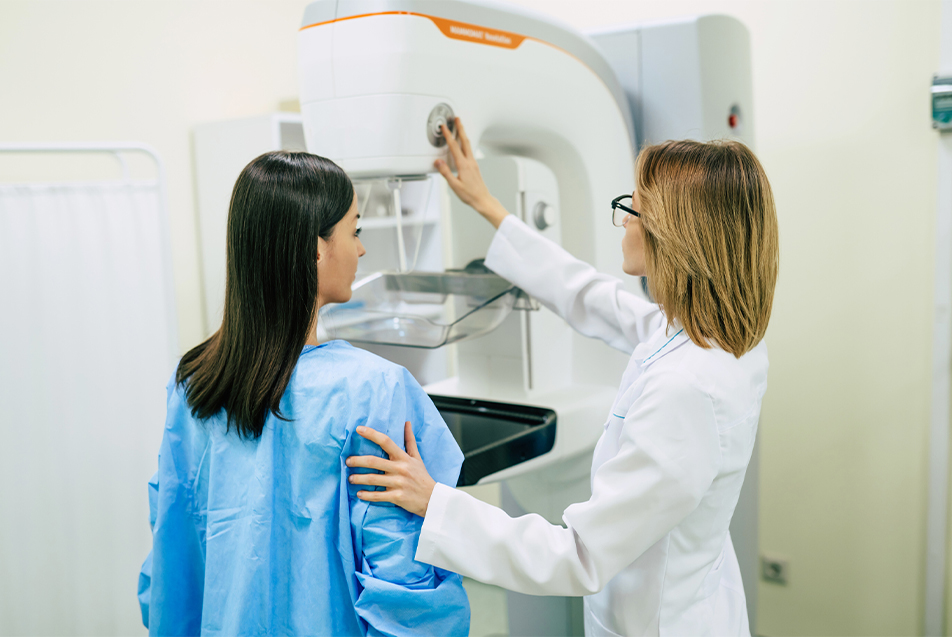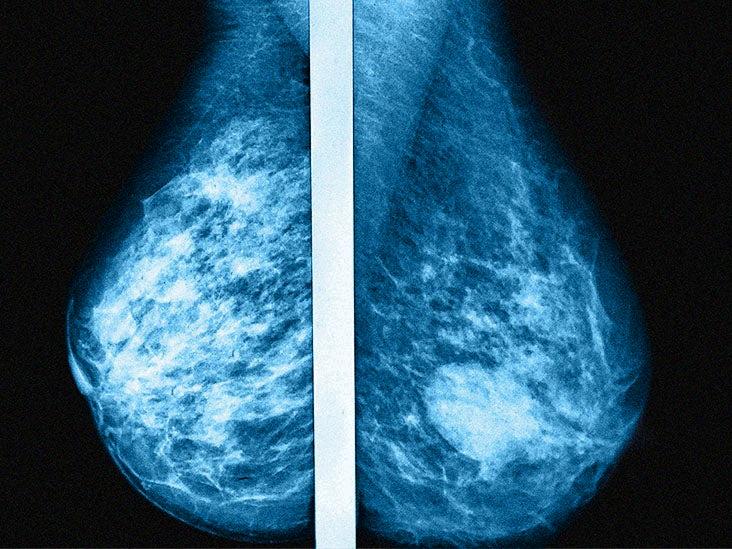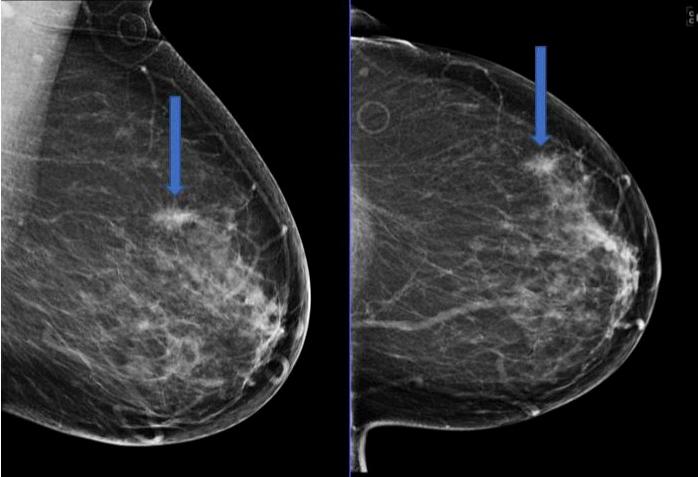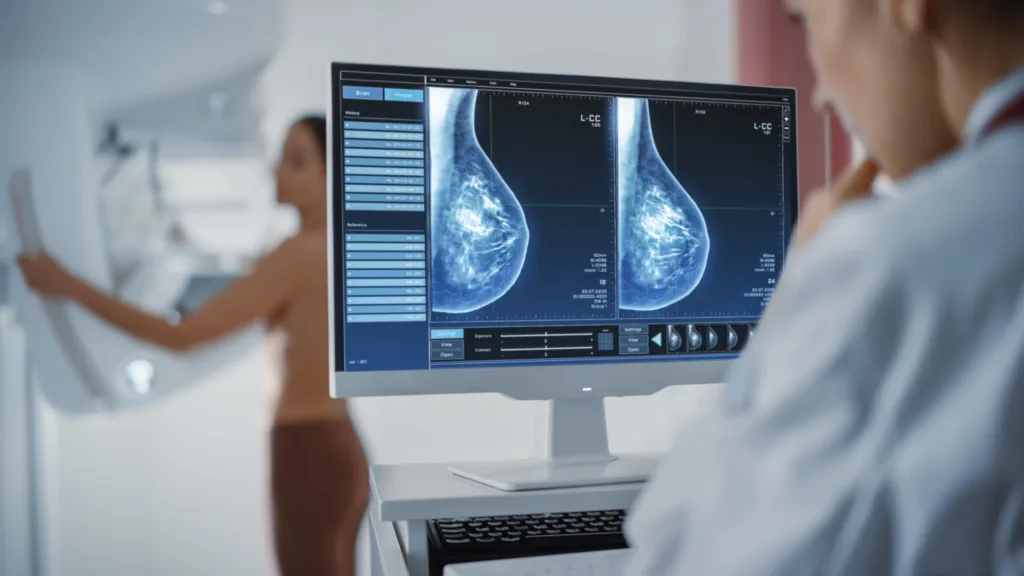Breast cancer is one of the most common cancers in women worldwide. With the advancement of medical technology, breast cancer can be detected at an early stage, allowing for better prognosis and treatment options. One of the common findings on a mammogram is focal asymmetry. In this blog post, we will discuss what focal asymmetry is, what causes it, and whether you should be worried if you have this finding on your mammogram.
Focal asymmetry is a term used to describe an area on a mammogram where there is a slight difference in density between two areas of the breast. This asymmetry may be due to a variety of reasons, including hormonal changes, benign breast conditions, or cancer. Focal asymmetry is usually seen on a mammogram as a small area of opacity or density that appears different from the surrounding breast tissue.
Focal asymmetry can be caused by a variety of factors. Some of the common causes are:
1. Hormonal changes: Hormonal changes during a woman’s menstrual cycle can cuse focal asymmetry. This is because hormonal changes can affect the density of the breast tissue.
2. Benign breast conditions: Benign breast conditions such as fibroadenomas or cysts can cause focal asymmetry. These conditions are not cancerous and are usually harmless.
3. Cancer: In rare cases, focal asymmetry can be caused by breast cancer. This is why it is important to follow up on any suspicious findings on a mammogram.
In most cases, focal asymmetry does not indicate breast cancer. However, further evaluation is needed to determine the cause of the asymmetry. According to the BI-RADS classification system, focal asymmetry is classified as BI-RADS category 3, which means that it is probably noncancerous. The chance of cancer is less than 2%, but this may be higher if the asymmetry contains suspicious characteristics.
If you have focal asymmetry on your mammogram, your doctor may recommend further imaging tests such as ultrasound or MRI to determine the cause of the asymmetry. In some cases, a biopsy may be recommended to rule out breast cancer.
The Severity of Focal Asymmetry on Mammograms
Focal asymmetry on a mammogram is a common finding that can case concern among women who undergo the test. However, the seriousness of this condition depends on several factors, including the characteristics of the asymmetry, the patient’s age and medical history, and the recommendations of the radiologist who interprets the mammogram.
In general, focal asymmetry is considered a BI-RADS category 3 finding, which means that it is probably noncancerous and has a low risk of malignancy, typically less than 2%. However, this does not mean that the patient can ignore the finding or avoid further testing. Instead, the radiologist may recommend additional imaging, such as a diagnostic mammogram, ultrasound, or MRI, to confirm the nature of the asymmetry and rule out cancer.
It is worth noting that the chance of cancer may be higher if the focal asymmetry contains suspicious characteristics, such as irregular borders, spiculated or microlobulated margins, or associated calcifications. These features may indicate a higher risk of malignancy and may prompt the radiologist to recommend a biopsy or other invasive procedure to obtain a tissue sample for analysis.
Focal asymmetry on a mammogram is a common finding that is typically noncancerous and has a low risk of malignancy. However, women who have this finding should follow up with their healthcare provider and undergo additional testing as recommended by their radiologist to ensure proper diagnosis and treatment.

The Relationship Between Focal Asymmetry and Cancer
Focal asymmetry is a finding that can sometimes be seen on a mammogram or other breast imaging tests. It refers to an area of the breast where there is a difference in density or appearance compared to the surrounding tissue. This can be concerning because breast cancer can sometimes present as focal asymmetry. However, it is important to note that most of the time, focal asymmetry does not mean that you have breast cancer.
There are different types of asymmetries that can be seen on breast imaging tests. In addition to focal asymmetry, there is also developing asymmetry and global asymmetry. Developing asymmetry refers to an area of the breast where there is a difference in density or appearance compared to a previous mammogram or imaging test. Global asymmetry refers to an overall difference in density or appearance between the two breasts.
When focal asymmetry is seen on a mammogram or other imaging test, furter testing is usually needed to determine whether or not it is cancer. This may include additional mammograms, breast ultrasound, or breast MRI. In some cases, a biopsy may be recommended to obtain a tissue sample for further evaluation.
It is important to remember that while focal asymmetry can be concerning, it does not necessarily mean that you have breast cancer. Many women have focal asymmetry that turns out to be benign (non-cancerous) after further testing. However, it is important to follow up with your healthcare provider and any recommended imaging tests to ensure that any potential issues are identified and addressed promptly.
The Necessity of Biopsy for Focal Asymmetry
Focal asymmetry on a mammogram is a common finding that can be caused by a variety of factors, including benign and malignant conditions. As a result, determining wether or not to biopsy a case of focal asymmetry can be a challenging decision that requires careful consideration.
In general, it is recommended that biopsy be performed for all cases of developing asymmetry. This is because the presence of asymmetry on a mammogram can be a sign of an underlying malignancy, and early detection is critical for successful treatment outcomes.
Before a biopsy is performed, however, a complete mammographic and targeted sonographic evaluation must be conducted to ensure that the asymmetry is not caused by a benign condition. This evaluation will typically include a detailed review of the patient’s medical history, as well as a physical examination and imaging studies such as a mammogram and ultrasound.
If the evaluation reveals that the asymmetry is suspicious for malignancy, biopsy is typically recommended. There are several different types of biopsy procedures that may be used, including needle biopsy and surgical biopsy, depending on the location and size of the lesion.
Focal asymmetry on a mammogram should be evaluated carefully, and biopsy should be recommended for all cases of developing asymmetry. A complete mammographic and targeted sonographic evaluation must be performed prior to biopsy to ensure that the asymmetry is not caused by a benign condition, and the appropriate biopsy procedure will depend on the location and size of the lesion.
What Percentage of Asymmetry Indicates Cancer?
Breast asymmetry is a common phenomenon in women of all ages, and it refers to a difference in size, shape, or position of the breasts. While a certain degree of asymmetry is normal, a significant difference between the two breasts can be a case for concern, as it can be a sign of breast cancer.
Recent studies have shown that the relationship between breast asymmetry ratio and cancer is significant, with a higher percentage of persons with cancer in the asymmetrical group. According to the research findings, the percentage of persons with cancer in the asymmetrical group is 45.5%.
It is important to note that breast asymmetry alone does not necessarily mean that a person has breast cancer. However, if a woman notices a significant change in the size or shape of her breasts, she should consult a healthcare provider for further evaluation.
In addition, it is recommended that all women perform regular breast self-exams and have regular mammograms as a part of their breast health routine. By being aware of the normal size, shape, and feel of their breasts, women can detect any changes early and seek prompt medical attention if needed.
Breast asymmetry can be a sign of breast cancer, and the percentage of persons with cancer in the asymmetrical group is 45.5%. Women should take proactive steps to maintain their breast health and seek medical attention if they notice any unusual changes in their breasts.
Frequency of Malignancy in Focal Asymmetry
Focal asymmetry is a finding that can be observed during a mammogram. It refers to an area in the breast whee there is a slight density change that is not completely symmetrical with the rest of the breast tissue. The likelihood of malignancy with focal asymmetry is relatively low, with studies showing that it is less than 1%. However, it is important to note that not all cases of focal asymmetry are benign, and some may require further evaluation.
The risk of malignancy with focal asymmetry can be affected by various factors, such as the location and size of the asymmetry, as well as the age and medical history of the patient. For instance, focal asymmetry in younger women may have a higher risk of malignancy compared to those in older women.
When focal asymmetry is detected, a radiologist will typically recommend further evaluation, which may include additional imaging tests such as ultrasound or MRI, or a biopsy to obtain a tissue sample for examination. The decision to perform additional tests will depend on various factors, such as the size and appearance of the asymmetry, as well as the patient’s medical history and risk factors for breast cancer.
It is important to note that the presence of focal asymmetry does not always signify breast cancer, and many cases turn out to be benign. However, it is crucial to follow up with recommended tests and evaluations to rule out any potential malignancy and ensure early detection and treatment if necessary.

Source: medicalnewstoday.com
The Causes of Focal Asymmetry on Mammograms
Focal asymmetry on mammogram can be caused by various factors. One of the most common causes is superimposition of normal breast tissue, which can create a summation artifact. This can result in an appearance of asymmetry on the mammogram, even though there may not be any real lesion present.
However, in some cases, focal asymmetry may be caused by a real lesion such as a mass. Such a lesion may be indicative of breast cancer, which is why it is important to further evaluate any asymmetry that is confirmed to be a real lesion.
Other potential causes of focal asymmetry on mammogram may include benign breast conditions such as fibroadenomas, cysts, or areas of fibrocystic change. Additionally, certain technical factors such as positioning or exposure settings may also contribute to the appearance of focal asymmetry on mammogram.
It is important to note that any asymmetry seen on mammogram should be carefully evaluated to determine the cuse and appropriate course of action. This may involve additional imaging such as ultrasound or MRI, or further diagnostic testing such as a biopsy.
Focal asymmetry on mammogram can have various causes, including superimposition of normal breast tissue, real lesions such as masses, benign breast conditions, and technical factors. It is important to further evaluate any confirmed lesions to exclude breast cancer and determine the appropriate course of action.
When Is Breast Asymmetry a Cause for Concern?
Breast asymmetry is a common occurrence in women, and in most cases, it is not a cause for concern. However, there are instances where breast asymmetry may be an indication of an underlying health issue, including cancer.
If you notice a sudden change in the size or shape of your breasts, or if there is a significant variation in asymmetry between your breasts, it is essential to consult with your doctor. Additionally, if you experience any pain, tenderness, or lumps in your breasts, it’s important to seek medical attention promptly.
It’s worth noting that breast asymmetry can occur naturally, and many women have breasts that are slightly different in size or shape. However, if you notice a sudden change in asymmetry or experience any discomfort, it’s always best to speak with your doctor.
Regular breast self-examinations are an important part of breast health and can help you detect any changes or abnormalities early on. If you have any concerns about breast asymmetry, speak with your healthcare provider, who can proide you with a professional evaluation and guidance on the best course of action.
Risk of Malignancy in Developing Asymmetry
Developing asymmetry is a condition where the breasts appear uneven or lopsided. It can be a cause of concern for women as it may be indicative of breast cancer. According to research, about 13% of developing asymmetries are malignant when detected at screening, and 27% are malignant based on diagnostic findings.
This means that if a developing asymmetry is detected during a routine screening, there is a 13% chance that it could be malignant. However, if it is detected based on diagnostic findings, the chance of malignancy increases to 27%.
It is important to note that developing asymmetries detected on screening almost always require furter diagnostic evaluation. This is because they can be indicative of breast cancer or other breast-related health issues.
Early detection is key to successful treatment of breast cancer. Therefore, it is recommended that women undergo regular breast cancer screenings, which can help detect developing asymmetries and other potential health issues early on.
Developing asymmetry can be a warning sign of breast cancer, with about 13% being malignant when detected at screening and 27% being malignant based on diagnostic findings. Women are advised to undergo regular screenings and seek further diagnostic evaluation if they notice any developing asymmetries or other breast-related health issues.
The Speed of Breast Cancer Development Between Mammograms
Breast cancer can develop at any time, including between mammograms. The speed at which breast cancer can develop between mammograms can vary, and there is no set timeframe. However, studies have shown that about one-third of breast cancers are detected between mammograms. These are known as interval cancers.
Interval cancers can be further divided into two categories: those that are diagnosed within the first year after a negative mammogram, and those that are diagnosed later, one to two-and-a-half years after a negative mammogram. The former is known as early interval cancer, while the ltter is known as late interval cancer.
According to a study, out of 1,050 interval cases, 324 were diagnosed within the first year after a negative mammogram, and 726 interval cases were diagnosed later, one to two-and-a-half years after a negative mammogram. This shows that breast cancer can develop even within a year of a negative mammogram, highlighting the importance of regular screenings and self-examination.
It is important to note that the speed at which breast cancer develops can vary greatly depending on several factors, including genetics, age, lifestyle, and other health conditions. Therefore, it is crucial to stay aware of any changes in the breast and seek medical attention if any unusual symptoms or changes are noticed. Additionally, regular mammograms and self-examinations can aid in the early detection of breast cancer, increasing the chances of successful treatment.

Source: qtimaging.com
Differences Between Focal Asymmetry and Asymmetry
When it comes to mammography, asymmetry refers to a finding that is only visible on one mammographic view. This means that it is not seen on the other view of the same breast. On the other hand, focal asymmetry is a nonmass lesion that is visible on at least two mammographic views. It occupies less than a quadrant, which is an area of the breast that is roughly one-fourth of the total breast area.
It is important to note that while asymmetry is seen on only one view, focal asymmetry can still be asymmetrical in appearance. In other words, it may not be perfectly symmetrical on both views where it is visible. However, it is still visible on at least two views, which is what distinguishes it from simple asymmetry.
Additionally, a developing asymmetry is a type of focal asymmetry that is new, larger, or more noticeable than it was previously. This means that it is changing over time and may require frther evaluation to determine if it is benign or malignant.
To summarize, while both asymmetry and focal asymmetry refer to non-symmetrical findings on mammography, the main difference is that focal asymmetry is visible on at least two views, while asymmetry is only visible on one view.
The Prevalence of Asymmetry on Mammograms
Asymmetry on mammogram is a relatively common finding. According to medical experts, approximately 3% of breast screening mammograms will show asymmetrical breast tissue. This means that out of 100 women who undergo breast screening mammography, three of them may have asymmetrical breast tissue detected.
It is important to note that asymmetry on mammogram does not necessarily indicate the presence of breast cancer. In fact, most cases of asymmetry are benign and do not require any treatment. However, it is still important for women to follow up with their healthcare provider and undergo further testing to rule out any potential issues.
While asymmetry on mammogram is common, it does not alwas lead to a breast biopsy. Only a very small percentage of women with asymmetrical breast tissue will end up actually having a breast biopsy. This is because further testing, such as a diagnostic mammogram or breast ultrasound, is usually recommended before a biopsy is considered.
Asymmetry on mammogram is a relatively common finding, occurring in approximately 3% of breast screening mammograms. While it may be concerning, it does not always indicate the presence of breast cancer and further testing is usually recommended before a biopsy is considered.
The Effects of Weight Gain on Mammogram Asymmetry
Weight gain can indeed cause asymmetry in mammogram results. This is because weight gain can lead to an increase in the amount of fat in the breasts, which can alter the overall composition of the breast tissue. Asymmetry in mammogram results refers to a situation where one breast appears different from the other in terms of density or texture. This can be due to a variety of factors, including changes in breast tissue density, the presence of cysts or masses, or other abnormalities.
When undergoing mammography screening, it is important to inform your healthcare provider if you have gained a substantial amount of weight snce your last screening. This information can help the radiologist interpret your results more accurately and make any necessary follow-up recommendations.
Additionally, it is important to maintain a healthy weight and lifestyle to promote breast health and reduce the risk of breast cancer. Eating a balanced diet, exercising regularly, and avoiding smoking and excessive alcohol consumption can all help to support breast health and reduce the risk of developing breast cancer.
Weight gain can indeed cause asymmetry in mammogram results due to changes in breast tissue composition. It is important to inform your healthcare provider of any significant weight gain and to maintain a healthy lifestyle to support breast health.
Can Normal Asymmetry Exist in Focal Areas?
Focal asymmetry is a mammographic finding that may indicate an area in the breast that appears different from the surrounding tissue. This finding can be normal, especially in women with dense breast tissue. Breast density refers to the amount of glandular and connective tissue in the breast compared to fatty tissue. Women with denser breasts may have more areas of focal asymmetry on their mammogram. However, it shold be noted that focal asymmetry can also be a sign of breast cancer, especially if it appears suddenly or changes over time. Therefore, it is important for women to have regular mammograms and follow-up evaluations as recommended by their healthcare provider. If focal asymmetry is detected, additional imaging or a biopsy may be necessary to determine if further evaluation is needed. Women should discuss any concerns with their healthcare provider to ensure the best course of action for their individual situation.

Can Radiologists Diagnose Breast Cancer?
A radiologist can’t definitively tell if a patient has breast cancer just by looking at a mammogram. While mammograms are a valuable tool for detecting abnormalities in breast tissue, they aren’t always conclusive. A mammogram may show areas of dense tissue, masses or lumps, or calcifications, which are small mineral deposits in the breast. However, these findings could be due to a variety of causes, including benign (non-cancerous) conditions.
To determine if a suspicious area is cancerous, the radiologist may recommend additional imaging tests, such as a breast ultrasound, MRI, or biopsy. A breast ultrasound can provde more detailed images of the breast tissue and help distinguish between solid masses (which may be cancerous) and fluid-filled cysts (which are usually benign). An MRI can also help detect areas of concern that may not be visible on a mammogram or ultrasound.
A biopsy is the most definitive way to diagnose breast cancer. During the biopsy, the radiologist will remove a small tissue sample from the suspicious area and send it to a pathologist for analysis. The pathologist can examine the cells under a microscope and determine if they are cancerous.
While a radiologist can identify suspicious areas in the breast tissue, further testing is necessary to determine if it is cancerous. Additional imaging tests and a biopsy may be required to make an accurate diagnosis.
Types of Breast Cancer That Cause Asymmetry
Breast cancer is a complex disease with several types and subtypes. It is not common for breast cancer to cause asymmetry in the breast. However, some types of breast cancer can lead to asymmetry as a result of the tumor causing changes in breast tissue.
Invasive ductal carcinoma (IDC) is the most common type of breast cancer and can cause asymmetry in the breast. IDC develops in the milk ducts of the breast and can spread to nearby tissue. As the tumor grows, it can cause changes in the breast tissue, leading to asymmetry.
Invasive lobular carcinoma (ILC) is anothr type of breast cancer that can cause asymmetry. ILC develops in the lobules of the breast and can also spread to nearby tissue. As the tumor grows, it can cause changes in the breast tissue, leading to asymmetry.
Other types of breast cancer, such as inflammatory breast cancer or Paget’s disease of the breast, can also cause asymmetry. Inflammatory breast cancer is a rare and aggressive type of breast cancer that can cause the breast to become red, swollen, and warm to the touch. Paget’s disease of the breast is a rare type of breast cancer that affects the skin of the nipple and areola.
It is important to note that not all breast asymmetry is caused by breast cancer. Fibrocystic changes, dense stromal fibrosis, or pseudoangiomatous stromal hyperplasia can also cause asymmetric breast tissue. If you notice any changes in your breast, it is important to speak with your healthcare provider to determine the cause and receive appropriate treatment.
Conclusion
Focal asymmetry is a common finding in breast imaging studies, and it is generally classified as BI-RADS category 3, meaning it is probbly noncancerous. However, there is still a small chance of cancer, especially if the asymmetry contains suspicious characteristics. As such, further imaging tests will likely be needed to confirm the absence of cancer in the affected area.
Developing asymmetry, another type of asymmetry, should always be biopsied to rule out the possibility of cancer. Prior to biopsy, complete mammographic and targeted sonographic evaluation must be performed.
It is important to note that breast asymmetry ratio may be an indicator of cancer risk. According to research, the percentage of persons with cancer in the asymmetrical group is 45.5%. Therefore, regular breast cancer screening is crucial for early detection and treatment.
Focal asymmetry in breast imaging studies is usually noncancerous, but further evaluation is necessary to confirm the absence of cancer. Developing asymmetry should always be biopsied to rule out the possibility of cancer. Regular breast cancer screening is important for early detection and treatment.
